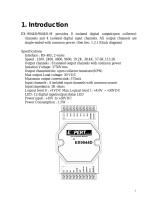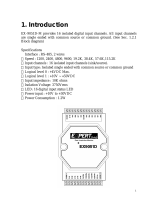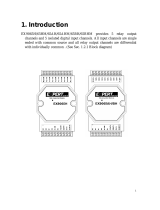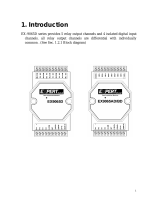Page is loading ...

I-7088 User Manual, Rev: A1.0
1
I-7088
User Manual
Warranty
All products manufactured by ICP DAS are warranted against
defective materials for a period of one year from the date of
delivery to the original purchaser.
Warning
ICP DAS assume no liability for damages consequent to the
use of this product. ICP DAS reserves the right to change this
manual at any time without notice. The information furnished by
ICP DAS is believed to be accurate and reliable. However, no
responsibility is assumed by ICP DAS for its use, nor for any
infringements of patents or other rights of third parties resulting
from its use.
Copyright
Copyright 2010 by ICP DAS. All rights are reserved.
Trademark
Names are used for identification purposes only and may be
registered trademarks of their respective companies.
Your Powerful Tools
Create New Ideas
Create New Applications
I-7000 New Features
1. Internal Self Tuner
2. Multiple Baud Rates
3. Multiple Data Formats
4. Internal Dual WatchDog
5. True Distributed Control
6. High Speed & High
Density I/O

I-7088 User Manual, Rev: A1.0
2
Table of Contents
1.
Introduction.............................................................4
1.1.
Pin Assignment...................................................6
1.2.
Specifications......................................................7
1.3.
Block Diagram.....................................................8
1.4.
Application Wiring ...............................................9
1.5.
Quick Start ........................................................10
1.6.
Default Setting...................................................11
1.7.
Configuration Tables.........................................11
2.
DCON Protocol.....................................................12
Checksum Calculation...............................................13
2.1.
%AANNTTCCFF...............................................16
2.2.
#AA ...................................................................19
2.3.
#AAN.................................................................20
2.4.
$AA2 .................................................................21
2.5.
$AA3N...............................................................23
2.6.
$AA3N(Data).....................................................24
2.7.
$AA5 .................................................................25
2.8.
$AA5VV.............................................................27
2.9.
$AA6 .................................................................28
2.10.
$AA6N...............................................................29
2.11.
$AA6NN............................................................30
2.12.
$AA7N...............................................................31
2.13.
$AAB.................................................................33
2.14.
$AABR ..............................................................34
2.15.
$AACnD............................................................35
2.16.
$AACnD(Data)..................................................36
2.17.
$AACnF.............................................................37
2.18.
$AACnF(Data)...................................................39
2.19.
$AACnM............................................................41
2.20.
$AACnMS .........................................................43
2.21.
$AACnP ............................................................45
2.22.
$AACnP(Data) ..................................................47
2.23.
$AACnT.............................................................49
2.24.
$AACnTS..........................................................51
2.25.
$AACnN............................................................53
2.26.
$AACnNS..........................................................55
2.27.
$AAF.................................................................56

I-7088 User Manual, Rev: A1.0
3
2.28.
$AAI ..................................................................57
2.29.
$AAM ................................................................58
2.30.
$AAR.................................................................59
2.31.
$AAW................................................................60
2.32.
$AAYS...............................................................61
2.33.
@AADODD.......................................................62
2.34.
@AADI..............................................................64
2.35.
@AAGN ............................................................66
2.36.
@AAPN(Data)...................................................67
2.37.
~AAD.................................................................68
2.38.
~AADVV............................................................70
2.39.
~AAO(Name) ....................................................72
2.40.
~AARD..............................................................73
2.41.
~AARDTT..........................................................74
2.42.
~**.....................................................................75
2.43.
~AA0.................................................................76
2.44.
~AA1.................................................................78
2.45.
~AA2.................................................................80
2.46.
~AA3ETT ..........................................................82
2.47.
~AAI..................................................................84
2.48.
~AATnn.............................................................86
3.
Operations Principle & Application Notes.............88
3.1
INIT* _pin Operation Principle ..........................88
3.2
PWM Operation Principle..................................89
A.
Appendix...............................................................91
A.1 INIT Mode............................................................91
A.2 Dual Watchdog Operation...................................93
A.3 Frame Ground.....................................................94
A.4 Node Information Area ........................................96
A.5 Reset Status........................................................97

I-7088 User Manual, Rev: A1.0
4
1. Introduction
The I-7088 has 8 PWM output channels and 8 counter inputs
and can be used to develop powerful and cost effective analog
control systems. PWM (Pulse width modulation) is a powerful
technique for controlling analog circuits that uses digital outputs
to generate a waveform with variant Duty Cycle (The fraction of
time that a system is in an "active" state) and frequency to control
analog circuits and can be used to control the position/speed of
motors, dim the brightness of lamps, control the speed of fans, etc.
The I-7088 will also automatically save the counter value to
EEPROM if the power supply is interrupted or lost. Refer to
Section 1.7 for details.
Features
Automatic hardware generation of PWM outputs without
software intervention
1Hz ~ 500KHz PWM output frequency with 0.1%~99.9%
duty cycle (Refer to Section 3.2)
Software and hardware trigger mode for PWM output
Individual and synchronous PWM output.
Using software trigger mode, you can set the configuration for
all PWM channels then trigger them individually or all of
them at the same time.
Burst mode PWM operation for standby
DI channel can be configured as either a simple digital input
channel or a hardware trigger source for the PWM output.
Software Trigger
PWM (Continuous Mode)
I-7088
MCU
DI / Hardware Trigger
PWM (Burst Mode)

I-7088 User Manual, Rev: A1.0
5
Applications
Controlling the position/speed of motors
Dimming the brightness of lamps
Controlling the speed of fans
More Information
Refer to chapter 1 of the “I-7000 Bus Converter User
Manual” for more information regarding the following:
1.1 I-7000 Overview
1.2 I-7000 Related Documentation
1.3 I-7000 Common Features
1.4 I-7000 System Network Configuration
1.5 I-7000 Dimensions

I-7088 User Manual, Rev: A1.0
6
1.1. Pin Assignments

I-7088 User Manual, Rev: A1.0
7
1.2. Specifications
PWM Output
Channels 8
Type TTL, Isolated
Max. Frequency 500KHz
Duty Cycle 0.1%~99.9%
PWM Mode
Burst mode,
Continuous mode
Burst Mode Counter 1~65535 counts
Trigger Start
Hardware or
Software
ESD Protection
4 kV Contact for each
terminal and 8 kV Air
for random point
Isolation 2500 VDC
Digital Input
Channels 8
Type Sink, Isolated
ON Voltage Level +2.4V~+5V
OFF Voltage Level +1V Max.
Max. Frequency 1MHz
Max. Counts
32-bits
(4,294,967,295)
Built-in Virtual Battery Backup for Counter Value Yes
ESD Protection
4 kV Contact fo
r each
terminal and 8 kV Air
for random point
Isolation 2500 V
DC
Interface
Interface RS-485
Format N, 8, 1
Baud Rate 1200 ~ 115200bps
LED Display
1 LED as Power/Communication Indicator
Dimension
72mm x 122mm x 35mm (W x L x H)
Power
Input Voltage Range 10 ~ 30 V
DC
Power Consumption 2.4 W (max.)
Power Reverse Polarity Protection Yes
+/- 4 kV ESD , +/- 4 kV EFT and +/- 3 kV Surge
Protection
Yes

I-7088 User Manual, Rev: A1.0
8
Environment
Operating Temperature -25 ~ 75°C
Storage Temperature -40 ~ 85°C
Humidity 5 ~ 95%, non-condensing
1.3. Block Diagram

I-7088 User Manual, Rev: A1.0
9
1.4. Application Wiring
1.4.1. PWM Wiring Connection
1.4.2. DI/Counter Wiring Connection

I-7088 User Manual, Rev: A1.0
10
1.5. Quick Start
Refer to http://www.icpdas.com/download/7000/manual.htm
and use the “DCON Utility” to control the module. Otherwise,
use “DCON Utility -> Terminal -> Command Line” and follow
the commands shown below.
DI Status and Counter
1. Type @01DI[Enter] Receive => !01xx01
2. Type $01500[Enter] Receive => !01
3. Type @01P200000000[Enter] Receive => !01
4. Type $0132FFFFFFFF[Enter] Receive => !01
5. Type $0162[Enter] Receive => !01
6. Type #012[Enter] Receive => >00000000
7. Type $01504[Enter] Receive => !01
8. Type #012[Enter] Receive => >xxxxxxxx
Step 1: Read the DI status channel 0 = 1, channel 1 =0, etc.
Step 2: Disable the DI counter of channel 2
Step 3: Set the DI preset counter value (00000000) of channel
2
Step 4: Set the DI max. counter value (FFFFFFFF) of channel
2
Step 5: Reset the DI counter of channel 2
Step 6: Read the DI counter value (00000000) of channel 2
Step 7: Enable the DI counter of channel 2
Step 8: Read the DI counter value (xxxxxxxx) of channel 2
PWM Output
1. Type $01C0F100000[Enter] Receive => !01100000
2. Type $01C0D50.0[Enter] Receive => !0150.0
3. Type $01C0M1[Enter] Receive => !01
4. Type @01DO01[Enter] Receive => !01
Step 1: Set the frequency of PWM channel 0 to 100KHz
Step 2: Set the duty cycle of PWM channel 0 to 50.0%
Step 3: Set PWM channel 0 to continuous mode
Step 4: Start the output of PWM channel 0

I-7088 User Manual, Rev: A1.0
11
1.6. Default Settings
The default setting is given as following:
Address=01
Baud Rate=9600
Checksum disable
Data=1 Start+8 Data+1 Stop (no parity)
PWM Frequency=10KHz
PWM Duty Cycle=50%
PWM Steps=1 (Continuous Type)
1.7. Configuration Tables
Baud Rate Setting (CC)
Code 03 04 05 06 07 08 09 0A
Baud Rate 1200
2400 4800 9600 19200
38400
57600
115200
Bits 7:6 Description
00 No parity and one stop bit
01 No parity and two stop bits
10 Even parity and one stop bit
11 Odd parity and one stop bit
Configuration Code Table (TT)
TT Input Range
50 Counter
52 Virtual Battery Backup
Note: For type 52, the count value will continue from the last
power off value.

I-7088 User Manual, Rev: A1.0
12
Data Format Setting (FF)
7 6 5 4 3 2 1 0
0 CS Reserved
Key Description
CS Checksum setting
0: Disabled
1: Enabled
Note: Reserved bits should be zero.
2. DCON Protocol
All communication with I-7000 modules consists of
commands generated by the host and responses transmitted by the
I-7000 module. Each module has a unique ID number that is used
for addressing purposes and is stored in non-volatile memory. The
ID is 01 by default and can be changed using a user command.
All commands sent to a module contain the ID address, meaning
that only the addressed module will respond. The only exception
to this is command ~** (Section 2.42), which are sent to all
modules, but, in these cases, the modules do not reply to the
command.
Command Format:
Leading
Character
Module
Address
Command [CHKSUM] CR
Response Format:
Leading
Character
Module
Address
Data [CHKSUM] CR
CHKSUM A 2-character checksum that is present when the
checksum setting is enabled. See Sections 1.7 and
2.1 for details.
CR End of command character, carriage return (0x0D)

I-7088 User Manual, Rev: A1.0
13
Checksum Calculation
1. Calculate the ASCII code sum of all the characters in the
command/response string, except for the carriage return
character (CR).
2. The checksum is equal to the sum masked by 0ffh.
Example:
Command string: $012(CR)
1. The Sum of the string = “$”+”0”+”1”+”2” =
24h+30h+31h+32h = B7h
2. Therefore the checksum is B7h, and so the CHKSUM = “B7”
3. The command string with the checksum = $012B7(CR)
Response string: !01200600(CR)
1. The Sum of the string =
“!”+”0”+”1”+”2”+”0”+”0”+”6”+”0”+”0” =
21h+30h+31h+32h+30h+30h+36h+30h+30h = 1AAh
2. Therefore the checksum is AAh, and so the CHKSUM = “AA”
3. The response string with the checksum = !01200600AA(CR)
Note:
All characters should be in upper case.

I-7088 User Manual, Rev: A1.0
14
General Command Sets
Command Response Description Section
%AANNTTCCFF
!AA
Sets the configuration of the
module
2.1
$AA2 !AANNTTCCFF
Reads the configuration of the
module
2.4
$AA5 !AAS Reads the module reset status 2.7
$AAF !AA(Data) Reads the firmware version 2.27
$AAI !AAS Reads the INIT status 2.28
$AAM !AA(Data) Reads the module name 2.29
~AAO(Name) !AA Sets the module name 2.39
~AARD !AATT Reads the response delay time 2.40
~AARDTT !AA Sets the response delay time 2.41
PWM Command Sets
Command Response Description Section
#AA >(Data) Reads the count 2.2
#AAN >(Data)
Reads the count of a specific
channel
2.3
$AA3N !AA Reads the max. counter value 2.5
$AA3N(data) !AA Sets the max. counter value 2.6
$AA5VV !AA Sets the counter status 2.8
$AA6 !AASS Reads the counter status 2.9
$AA6N !AA
Resets the counter of a specific
channel
2.10
$AA6NN !AA Resets the counter 2.11
$AA7N !AAS Reads the overflow status 2.12
$AAB !AAS Reads the power off count 2.13
$AABR !AA Clears the power off count 2.14
$AACnD !AA(data) Reads the duty cycle value 2.15
$AACnD(data) !AA Sets the duty cycle value 2.16
$AACnF !AA(data) Reads the frequency 2.17
$AACnF(data) !AA Sets the frequency 2.18
$AACnM !AAS
Reads the status of continuous
mode
2.19
$AACnMS !AA Sets the continuous mode 2.20
$AACnP !AA(data) Reads the steps value 2.21

I-7088 User Manual, Rev: A1.0
15
$AACnP(data) !AA Sets the steps value 2.22
$AACnT !AAS Reads the trigger configuration 2.23
$AACnTS !AA Sets the trigger configuration 2.24
$AACnN !AAS Reads the PWM synchronization 2.25
$AACnNS !AA Sets the PWM synchronization 2.26
$AAR !AA Resets the PWM 2.30
$AAW !AA Saves the PWM configuration 2.31
$AAYS !AA Starts the PWM synchronization 2.32
@AADODD !AA Sets the PWM status 2.33
@AADI !AAOO Reads the DI/O status 2.34
@AAGn !AA(data) Reads the preset value 2.35
@AAPN(data) !AA Sets the preset value 2.36
~AAD !AASS Reads the miscellaneous 2.37
~AADVV !AA Sets the miscellaneous 2.38
Host Watchdog Command Sets
Command Response Description Section
~** No Response The Host is OK 2.42
~AA0 !AASS Reads the host watchdog status 2.43
~AA1 !AA Resets the host watchdog status 2.44
~AA2 !AAETT
Reads the host watchdog timeout
settings
2.45
~AA3ETT !AA
Sets the host watchdog timeout
settings
2.46
~AAI !AA Sets Soft INIT 2.47
~AATnn !AA Sets the Soft INIT timeout value 2.48

I-7088
I-7088 User Manual, Rev: A1.0
16
2.1. %AANNTTCCFF
Description:
This command is used to set the configuration of a module.
Syntax:
%AANNTTCCFF[CHKSUM](CR)
% Delimiter character
AA The address of the module to be configured in
hexadecimal format (00 to FF)
NN The new address of the module in hexadecimal format
(00 to FF)
TT The new type code, see Section 1.7 for details
CC The new Baud Rate code, see Section 1.7 for details.
For the I-7088, the rear slide switch must be moved to
the INIT position in order to change Baud Rates. See
Section A.1 for details.
FF The command used to set the data format, checksum,
and filter settings (Section 1.7). For the I-7088, the
rear slide switch must be moved to the INIT position
in order to change the checksum setting. See Section
A.1 for details.
Response:
Valid Command: !AA[CHKSUM](CR)
Invalid Command: ?AA[CHKSUM](CR)
! Delimiter for a valid command
? Delimiter for an invalid command
(If the Baud Rate or checksum settings are changed
without switching the rear slide switch to the INIT
position, the module will return an invalid command.)
AA The address of the module in hexadecimal format (00
to FF)

I-7088
I-7088 User Manual, Rev: A1.0
17
There will be no response if the command syntax is incorrect,
there is a communication error, or there is no module with the
specified address.
Examples:
Command: %0102500600 Response: !02
Changes the address of module 01 to 02 and the module
returns a valid response.
Command: %0202520600 Response: !02
Sets the type of module 02 to be 52 (Virtual Battery
Backup) and the module returns a valid response.
Command: %0202520A00 Response: ?02
Changes the Baud Rate of module 02 to 115200bps and
the module returns an invalid response, because it is not in
INIT mode.
Command: %0202520A00 Response: !01
Changes the Baud Rate of module 02 to 115200bps and
the module is in INIT mode. The module returns a valid
response.
Related Commands:
Section 2.4 $AA2, Section 2.47 ~AAI, Section 2.48 AATnn
Related Topics
Section 1.7 Configuration Tables, Section A.1 INIT pin Operation
Notes:
1. Changes to the address, type code and data format settings
take effect immediately after a valid command is received.
Changes to the Baud Rate and checksum settings take effect
on the next power-on reset.
2. For the I-7088, changing the Baud Rate and checksum
settings can only be achieved using software only and is
performed by using the following commands:
I. Send a ~AATnn command. See Section 2.48 for details.
II. Send a ~AAI command. See Section 2.47 for details.
III. Send a %AANNTTCCFF command.

I-7088
I-7088 User Manual, Rev: A1.0
18
If the command is valid, the Baud Rate and checksum
settings will be changed after the module responds with !AA.

I-7088
I-7088 User Manual, Rev: A1.0
19
2.2. #AA
Description:
This command is used to read the DI count.
Syntax:
#AA[CHKSUM](CR)
# Delimiter character
AA The address of the module to be read (00 to FF)
Response:
Valid Command: >(Data)[CHKSUM](CR)
Invalid Command: ?AA[CHKSUM](CR)
> Delimiter character for a valid command
? Delimiter character for an invalid command
(Data) Count data from all DI channels
AA The address of the responding module (00 to FF)
There will be no response if the command syntax is incorrect,
there is a communication error, or there is no module with the
specified address.
Examples:
Command: #01 Response:
>0000000800000090000000A000000B000000C000000D000000
E0000000F
Reads module 01 and returns the count of DI channel 0 (8),
channel 1 (9), etc.
Related Commands:
Section 2.3 #AAN

I-7088
I-7088 User Manual, Rev: A1.0
20
2.3. #AAN
Description:
This command is used to read the count of a specific channel.
Syntax:
#AAN[CHKSUM](CR)
# Delimiter character
AA The address of the module to be read (00 to FF)
N The channel to be read, zero based
Response:
Valid Command: >(Data)[CHKSUM](CR)
Invalid Command: ?AA[CHKSUM](CR)
> Delimiter character for a valid command
? Delimiter character for an invalid command
(An invalid command is returned if the specified
channel is incorrect)
(Data) The DI count of the specified channel
AA The address of the responding module (00 to FF)
There will be no response if the command syntax is incorrect,
there is a communication error, or there is no module with the
specified address.
Examples:
Command: #032 Response: >00000008
Reads data from channel 2 of module 03.
Command: #029 Response: ?02
Reads data from channel 9 of module 02. An error is
returned because channel 9 is invalid.
Related Commands:
Section 2.2 #AA
/





